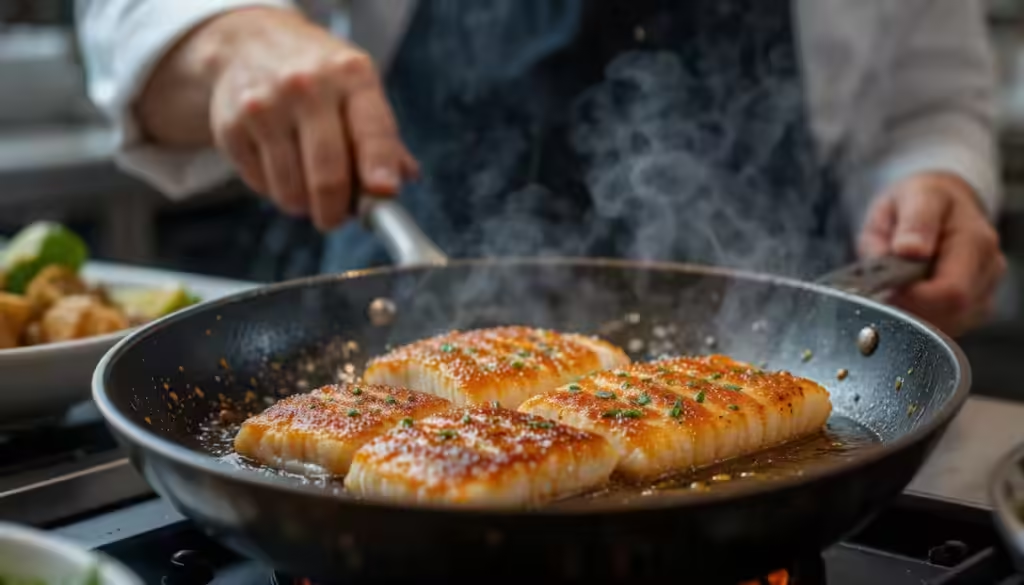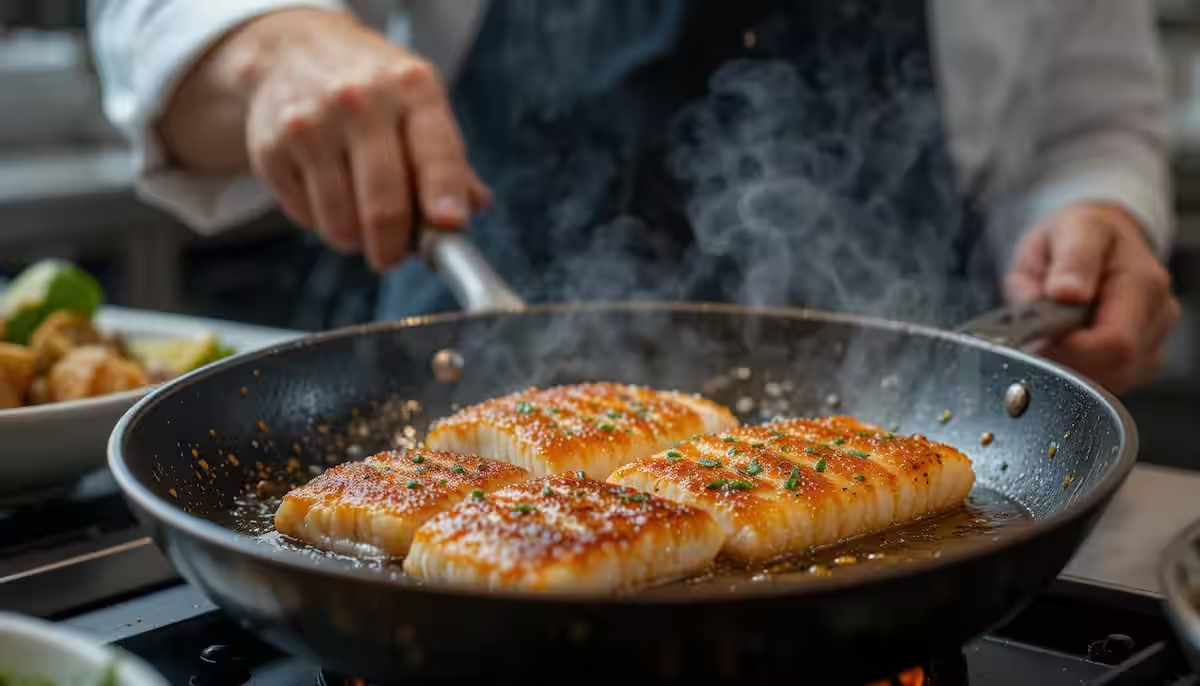Fried mahi mahi is a delightful way to enjoy this versatile fish. This method brings out its natural flavors. The mild taste and firm texture make it perfect for frying.
The Amazing Appeal of Fried Mahi Mahi
Mahi mahi, also known as dolphinfish (though not related to dolphins), offers a delicious and healthy meal option. The relatively quick cooking time and ease of preparation add to its appeal. Furthermore, fried mahi mahi can be adapted to various culinary styles. It seamlessly fits into tacos, sandwiches, or as a standalone dish.
Health Benefits of Mahi Mahi
Mahi mahi is packed with nutrients. It is an excellent source of lean protein, crucial for muscle building and repair. In addition, it contains omega-3 fatty acids, beneficial for heart health and brain function. This fish also provides essential vitamins and minerals. These include vitamin B12, selenium, and potassium. Therefore, incorporating mahi mahi into your diet can contribute to overall well-being.
Selecting the Freshest Mahi Mahi
Choosing fresh mahi mahi is essential for the best flavor and texture. Look for fillets that are firm, moist, and have a vibrant color. A slight, sea-like aroma is acceptable, but avoid fish that smells overly fishy or ammonia-like. If possible, purchase from a reputable fishmonger who can provide information about the fish’s origin and freshness. Furthermore, properly stored mahi mahi will maintain its quality.
Essential Steps for Frying Mahi Mahi
Mastering the art of frying mahi mahi involves a few critical steps. Proper preparation ensures a moist and flavorful result. Let’s explore the essential techniques.
Preparing the Mahi Mahi Fillets
Start by patting the mahi mahi fillets dry with paper towels. This step helps to achieve a crispy crust during frying. Trim any excess skin or membranes. Lightly season the fillets with salt, pepper, and any desired spices. Consider adding a touch of garlic powder, paprika, or citrus zest for extra flavor. In addition, ensure the fillets are evenly seasoned.
Choosing the Right Cooking Oil
The type of oil you use can significantly impact the flavor and texture of the fried mahi mahi. Opt for oils with a high smoke point, such as canola oil, vegetable oil, or peanut oil. These oils can withstand the high temperatures required for frying without breaking down. Furthermore, avoid oils with strong flavors that might overpower the delicate taste of the fish.
Achieving the Perfect Frying Temperature
Maintaining the correct oil temperature is crucial for achieving a golden-brown, crispy exterior while keeping the inside moist. Aim for a temperature between 350°F and 375°F (175°C to 190°C). Use a deep-fry thermometer to monitor the temperature accurately. If the oil is not hot enough, the fish will absorb too much oil and become greasy. Conversely, if the oil is too hot, the fish will burn on the outside before it cooks through. Therefore, careful temperature control is essential.
Frying Techniques for Optimal Results
Carefully place the seasoned mahi mahi fillets into the hot oil. Avoid overcrowding the pan, as this will lower the oil temperature and result in uneven cooking. Fry the fillets for 3-4 minutes per side, or until they are golden brown and cooked through. The internal temperature should reach 145°F (63°C). Remove the fillets from the oil and place them on a wire rack to drain excess oil. In addition, this helps to maintain the crispy texture.

Fried Mahi Mahi: 3 Delicious Variations
Fried mahi mahi is a blank canvas for culinary creativity. There are numerous ways to add unique flavors and textures to this dish. Explore these three delicious variations:
Beer-Battered Fried Mahi Mahi
For a crispy and flavorful coating, try beer batter. Combine flour, beer, baking powder, and seasonings to create a light and airy batter. Dip the mahi mahi fillets into the batter and deep-fry until golden brown. The beer adds a subtle tang and enhances the crispiness of the crust. Furthermore, this is a popular choice for fish and chips variations.
Coconut-Crusted Fried Mahi Mahi
Add a tropical twist with a coconut crust. Combine shredded coconut, breadcrumbs, and spices to create a flavorful coating. Dip the mahi mahi fillets into the mixture and pan-fry until golden brown. The coconut adds a subtle sweetness and a delightful crunch. In addition, serve with a mango salsa for a complementary flavor profile.
Blackened Fried Mahi Mahi
For a bold and spicy flavor, try blackening the mahi mahi. Coat the fillets with a blend of Cajun spices, such as paprika, cayenne pepper, garlic powder, and onion powder. Sear the fillets in a hot skillet until blackened on both sides. The spices create a flavorful crust and a slightly smoky taste. Therefore, this method is perfect for those who enjoy a bit of heat.
Serving Suggestions for Fried Mahi Mahi
Fried mahi mahi is a versatile dish that pairs well with various sides and sauces. Consider these serving suggestions:
Classic Sides
Serve fried mahi mahi with classic sides like French fries, coleslaw, and tartar sauce. These traditional accompaniments complement the crispy fish and create a satisfying meal. In addition, a squeeze of lemon juice adds a bright, refreshing touch.
Creative Sides
Experiment with creative sides like grilled vegetables, quinoa salad, or sweet potato fries. These options add nutritional value and interesting flavors to the meal. Consider pairing the fish with a vibrant salsa or a creamy avocado dip. Furthermore, these additions can elevate the dish.
Sauce Pairings
Enhance the flavor of fried mahi mahi with a complementary sauce. Tartar sauce, remoulade sauce, and aioli are classic choices. For a lighter option, try a lemon-dill sauce or a mango salsa. Furthermore, experiment with different sauces to find your favorite combination.
Fried Mahi Mahi Fundamentals
Key Benefits
- Delicious Flavor: Offers a mild, subtly sweet taste that appeals to many palates. The delicate flavor is enhanced by the frying process.
- Quick Cooking Time: Fries up quickly, making it a convenient meal option for busy weeknights. From preparation to plating, the entire process can be completed in under 30 minutes.
- Versatile: Can be used in tacos, sandwiches, or served as a main course. The possibilities are endless, limited only by your culinary creativity.
Potential Drawbacks
- Can Dry Out: Overcooking can lead to dryness, so careful monitoring is essential. Use a meat thermometer to ensure it reaches the correct internal temperature without overcooking.
- Oil Absorption: If not fried at the right temperature, it can absorb too much oil. Maintaining the correct oil temperature and using a wire rack to drain excess oil are crucial.
- Sustainability Concerns: Ensure the mahi mahi is sourced sustainably to minimize environmental impact. Look for certifications from organizations like the Marine Stewardship Council.
Tips for Achieving Ultimate Crispiness
- Double Dredge: For extra crispiness, try double-dredging the mahi mahi fillets. First, coat them in flour, then dip them in an egg wash, and finally coat them in breadcrumbs or your desired coating.
- Cornstarch Addition: Add a tablespoon or two of cornstarch to your flour mixture to enhance crispiness. Cornstarch absorbs moisture and creates a lighter, crispier texture.
- Cold Ingredients: Use cold beer or club soda in your batter to create a light and airy texture. The cold liquid helps to prevent the gluten in the flour from developing too much, resulting in a crispier coating.
- Don’t Overcrowd: Fry the fish in batches to avoid overcrowding the pan. Overcrowding lowers the oil temperature and results in soggy fish.
- High Heat: Ensure the oil is hot enough before adding the fish. The oil should be between 350°F and 375°F (175°C to 190°C).
Healthier Alternatives to Frying
If you’re looking for healthier alternatives to frying mahi mahi, consider these options:
Air Frying: Air fry the mahi mahi fillets at 400°F (200°C) for 8-10 minutes, or until cooked through. Lightly spray the fillets with oil before air frying.
Baking: Bake the mahi mahi fillets in the oven at 375°F (190°C) for 12-15 minutes, or until cooked through. Season with your favorite spices and herbs.
Grilling: Grill the mahi mahi fillets over medium heat for 4-5 minutes per side, or until cooked through. Marinate the fish beforehand for added flavor.
Pan-Searing: Pan-sear the mahi mahi fillets in a lightly oiled skillet over medium-high heat for 3-4 minutes per side, or until cooked through. Season with your favorite spices and herbs.
FAQ
Yes, mahi mahi is an excellent fish to fry. Its firm texture holds up well during frying. The mild flavor also complements various seasonings and cooking styles, making it a versatile choice for a variety of dishes.
Why is mahi mahi on the avoid list?
Sometimes mahi mahi is on the avoid list due to concerns about overfishing or unsustainable fishing practices in certain regions. These concerns vary depending on the location and fishing methods used. Always check the source and look for sustainably certified options to ensure responsible consumption and support sustainable fishing practices.
What does cooked mahi mahi taste like?
Cooked mahi mahi has a mild, slightly sweet flavor. The taste is often described as similar to swordfish or tuna, but less pronounced and with a more delicate texture. Its delicate flavor profile makes it versatile for different culinary applications, allowing it to pair well with a variety of sauces and sides.
Is mahi mahi a good fish to eat?
Mahi mahi is a nutritious and delicious fish to eat. It’s high in protein, omega-3 fatty acids, and essential vitamins and minerals, making it a healthy addition to your diet. However, as with any seafood, it’s important to source it from reputable suppliers to avoid mercury contamination and support sustainable fishing practices. Look for certifications like the Marine Stewardship Council (MSC) to ensure that the fish is sustainably sourced.

